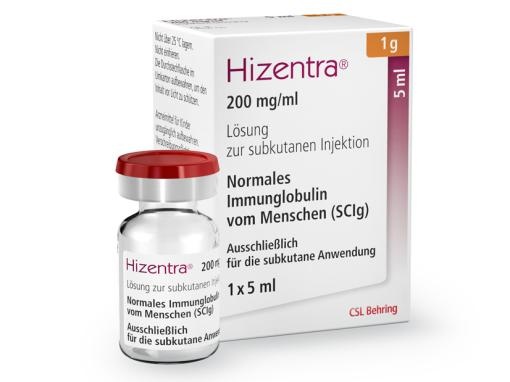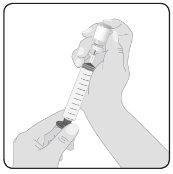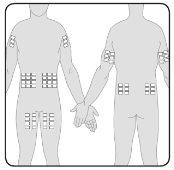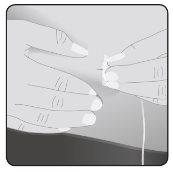

ХІЗЕНТРА 200 мг/мл Розчин для підшкірних ін'єкцій

Запитайте лікаря про рецепт на ХІЗЕНТРА 200 мг/мл Розчин для підшкірних ін'єкцій

Інструкція із застосування ХІЗЕНТРА 200 мг/мл Розчин для підшкірних ін'єкцій
Вступ
Опис: інформація для користувача
Хізентра 200 мг/мл розчин для підшкірного введення
нормальна людська імуноглобуліна (IgSC = Імуноглобулін Підшкірний)
Прочитайте уважно весь опис перед початком використання цього лікарського засобу, оскільки він містить важливу інформацію для вас.
- Збережіть цей опис, оскільки вам може знадобитися знову його прочитати.
- Якщо у вас виникли питання, проконсультуйтеся з вашим лікарем, фармацевтом або медсестрою.
- Цей лікарський засіб призначений тільки вам і не слід давати його іншим людям, навіть якщо вони мають相同ні симптоми захворювання, оскільки це може їм зашкодити.
- Якщо ви відчуваєте побічні ефекти, проконсультуйтеся з вашим лікарем, фармацевтом або медсестрою, навіть якщо це побічні ефекти, які не вказані в цьому описі. Див. розділ 4.
Зміст опису
- Що таке Хізентра і для чого вона використовується
- Що потрібно знати перед початком використання Хізентри
- Як використовувати Хізентру
- Можливі побічні ефекти
- Зберігання Хізентри
- Зміст упаковки та додаткова інформація
1. Що таке Хізентра і для чого вона використовується
Що таке Хізентра
Хізентра належить до класу лікарських засобів, званих нормальними людськими імуноглобулінами. Імуноглобуліни також називаються антитілами і є білками крові, які допомагають організмові боротися з інфекціями.
Як діє Хізентра
Хізентра містить імуноглобуліни, які отримані з крові здорових людей. Імуноглобуліни виробляються імунною системою організму. Вони допомагають організмові боротися з інфекціями, викликаними бактеріями і вірусами, або підтримувати баланс імунної системи (відомий як імуномодуляція). Лікарський засіб діє точно так само, як і імуноглобуліни, які присутні природним чином у крові.
Для чого використовується Хізентра
Замісна терапія
Хізентра використовується для підвищення низьких рівнів імуноглобулінів у крові до нормальних рівнів (замісна терапія). Лікарський засіб використовується у дорослих і дітей (0-18 років) у таких ситуаціях:
- Лікування пацієнтів, які народилися з низькою здатністю або нездатністю виробляти імуноглобуліни (первинні імунодефіцити). Це включає умови типу:
- Низькі рівні імуноглобулінів (гіпогаммаглобулінемія) або відсутність імуноглобулінів у крові (агаммаглобулінемія)
- Комбінація низьких рівнів імуноглобулінів, частих інфекцій і нездатності виробляти адекватні рівні антитіл після вакцинації (змінна імунодефіцитна хвороба)
- Комбінація низьких рівнів або відсутності імуноглобулінів, а також відсутності або нездатності функціонувати імунних клітин (важка комбінована імунодефіцитна хвороба)
- Відсутність певних підкласів імуноглобулінів G, які викликають повторювані інфекції.
- Лікування пацієнтів з низькими або дисфункціональними рівнями імуноглобулінів у набутих умовах (вторинна імунодефіцитна хвороба), які переживають важкі або повторювані інфекції через ослаблену імунну систему внаслідок інших захворювань або лікування.
Імуномодуляційна терапія у пацієнтів з ХПДІК
Хізентра також використовується у пацієнтів з хронічною демієлінізаційною полінеуропатією (ХПДІК), типом автоімунної хвороби. ХПДІК характеризується хронічним запаленням периферійних нервів, яке викликає м'язову слабкість і/або оніміння переважно в ногах і руках. Гіпотеза полягає в тому, що атака імунної системи посилює цей запалення, а імуноглобуліни Хізентри допомагають захистити нерви від атаки (імуномодуляційна терапія).
2. Що потрібно знати перед початком використання Хізентри
НІв/в вводити Хізентру:
- Якщо ви алергічні на людські імуноглобуліни, полісорбат 80 або Л-пролін.
- Повідоміть вашому лікареві або медичному працівнику перед лікуванням, якщо ви раніше мали непереносимість будь-якого з цих компонентів.
- Якщо ви страждаєте на гіперпролінемію (генетичний розлад, викликаний наявністю в крові високих рівнів амінокислоти проліну).
У судинах.
Попередження та обережність
- Проконсультуйтеся з вашим лікарем, фармацевтом або медсестрою перед використанням Хізентри.
Ви можете бути алергічними (гіперчутливими) до імуноглобулінів без знання про це. Однак справжні алергічні реакції рідкісні. Вони можуть виникнути, навіть якщо ви раніше приймали людські імуноглобуліни і добре переносили їх. Це може статися особливо якщо у вас недостатньо імуноглобулінів типу А (IgA) у крові (дефіцит IgA).
- Повідоміть вашому лікареві або медичному працівнику, якщо ви маєте дефіцит імуноглобулінів типу А (IgA) перед початком лікування. Хізентра містить залишкові кількості IgA, які можуть викликати алергічні реакції.
У цих рідкісних випадках можуть виникнути алергічні реакції, такі як раптове зниження артеріального тиску або шок(див. також розділ 4. "Можливі побічні ефекти").
- Якщо ви відчуваєте симптоми цього типу під час введення Хізентри, зупіньте введення і негайно зверніться до вашого лікаря або до найближчої лікарні.
- Повідоміть вашому лікареві, якщо ви маєте історію захворювання серця або судин, або якщо ви мали утворення кров'яних згустків, маєте густу кров або були імобілізовані протягом певного часу. Ці фактори можуть збільшити ваш ризик утворення кров'яного згустку після прийому Хізентри. Також повідоміть вашому лікареві, які лікарські засоби ви приймаєте, оскільки деякі з них містять естрогени (гормон, який міститься, наприклад, у контрацептивних таблетках), які можуть збільшити ваш ризик розвитку кров'яного згустку. Негайно зверніться до вашого лікаря, якщо ви відчуваєте ознаки і симптоми, такі як труднощі з диханням, біль у грудній клітці, біль і набряк кінцівки, слабкість або оніміння однієї сторони тіла після прийому Хізентри.
- Зверніться до вашого лікаря, якщо ви відчуваєте такі ознаки і симптоми: гострий головний біль, ригідність шиї, сонливість, гарячка, фотофобія, нудота і блювота після прийому Хізентри. Ваш лікар вирішить, чи потрібно проводити додаткові дослідження і чи слід продовжувати лікування Хізентрою.
Ваш лікар буде уникати можливих ускладнень, перевіряючи, що:
- Ви не чутливі до людської імуноглобуліни нормальної.
Продукт повинен вводитися з повільною початковою швидкістю. Необхідно суворо дотримуватися рекомендованої швидкості введення, вказаної в розділі 3 "Як використовувати Хізентру".
- Було проведено ретельний нагляд за наявністю будь-яких симптомів протягом усього періоду
введення, особливо якщо:
- це перша раз, коли ви приймаєте людську імуноглобулін нормальну
- ви змінили лікування іншим лікарським засобом
- між останнім введенням і цим пройшло тривалий період (більше ніж 8 тижнів).
У цих випадках вам слід спостерігати під час першого введення і протягом години після нього. Якщо вищезазначені пункти не можуть бути застосовані до вас, рекомендується спостерігати вас протягом щонайменше 20 хвилин після введення.
Взаємодія Хізентри з іншими лікарськими засобами
- Повідоміть вашому лікареві або фармацевту, якщо ви використовуєте, нещодавно використовували або можете використовувати будь-який інший лікарський засіб.
- Не слід змішувати Хізентру з іншими лікарськими засобами.
- Перед вакцинацією повідоміть вашому лікареві про ваше лікування Хізентрою.
Хізентра може змінити дію деяких вакцин з живими вірусами, таких як вакцина проти кору, краснухи, епідемічного паротиту і вітряної віспи. Тому після введення цих лікарських засобів слід чекати щонайменше 3 місяці перед прийомом живої вакцини. У випадку вакцини проти кору ця зміна може тривати до 1 року.
Вагітність, лактація та фертильність
- Якщо ви вагітні або годуєте грудьми, або вважаєте, що можете бути вагітною або маєте намір завагітніти, повідоміть вашому лікареві або фармацевту. Ваш лікар вирішить, чи можете ви приймати Хізентру під час вагітності або годування грудьми.
Не проводилися дослідження Хізентри у вагітних жінок. Однак лікарські засоби, які містять імуноглобуліни, використовувалися у вагітних жінок або під час годування грудьми протягом багатьох років, і не спостерігалося шкідливого впливу на перебіг вагітності або на дитину.
Якщо ви годуєте грудьми і приймаєте Хізентру, імуноглобуліни лікарського засобу також можуть бути присутні в грудному молоці. Тому ваша дитина може бути захищена від деяких інфекцій.
Водіння транспортних засобів та використання машин
Під час лікування Хізентрою пацієнти можуть відчувати ефекти, такі як головокружіння або нудота, які можуть впливати на здатність водити транспортні засоби та використовувати машини. Якщо це відбувається, не слід водити транспортні засоби та використовувати машини до тих пір, поки ці ефекти не зникнуть.
Хізентра містить пролін
Не слід приймати цей лікарський засіб, якщо ви страждаєте на гіперпролінемію (див. також розділ 2 "Що потрібно знати перед початком використання Хізентри"). Повідоміть вашому лікареві перед лікуванням.
Інша важлива інформація про Хізентру
Аналізи крові
Після прийому Хізентри результати деяких аналізів крові (серологічні тести) можуть бути змінені протягом певного часу.
- Перед проведенням будь-якого аналізу крові повідоміть вашому лікареві про ваше лікування Хізентрою.
Інформація про складові частини Хізентри
Хізентра виготовляється з плазми людської крові (це частина рідини крові). Коли лікарські засоби виготовляються з крові або плазми людини, проводяться певні заходи для уникнення передачі інфекцій пацієнтам. Ці заходи включають:
- ретельний відбір донорів крові або плазми для забезпечення виключення потенційних носіїв інфекцій, та
- перевірку кожної донорської крові та плазми на відсутність ознак вірусів або інфекцій.
Виробники цих лікарських засобів також включають етапи обробки крові або плазми, які можуть інактивувати або усунути віруси. Незважаючи на ці заходи, при введенні лікарських засобів, виготовлених з крові або плазми людини, не можна повністю виключити можливість передачі інфекції. Це також стосується будь-якого невідомого вірусу або іншого типу інфекції.
Заходи, прийняті для уникнення передачі інфекцій, вважаються ефективними для вірусів з оболонкою, таких як вірус імунодефіциту людини (ВІЛ, вірус СНІДу), вірус гепатиту Б і вірус гепатиту С (запалення печінки), а також для вірусів без оболонки, таких як вірус гепатиту А і парвовірус Б19.
- Рекомендується зберігати записи про назву та номер партії продукту кожного разу, коли ви приймаєте дозу Хізентри, щоб мати реєстр використаних партій (див. розділ 3, "Як використовувати Хізентру").
Хізентра містить натрій
Цей лікарський засіб містить менше 23 мг натрію (1 ммоль) на флакон/шприц; тобто, він практично "не містить натрію".
3. Як використовувати Гізентру
Слідувати точно інструкціям щодо застосування цього лікарського засобу, вказаним вашим лікарем. Проінформуйте свого лікаря, якщо у вас виникли питання.
Доза
Ваш лікар визначить, яку кількість Гізентри ви отримуватимете, залежно від вашої ваги та реакції на лікування.
Дозу або інтервал введення не слід змінювати без консультації з лікарем.
Якщо ви вважаєте, що повинні отримувати Гізентру частіше або рідше, проінформуйте свого лікаря. Якщо ви вважаєте, що пропустили дозу, поговоріть зі своїм лікарем якомога скоріше.
Замісна терапія
Ваш лікар визначить, чи вам потрібна доза завантаження (для дорослих і дітей) не менше 1-2,5 мл/кг ваги тіла, розділена на кілька днів. Після цього вводяться підтримувальні дози з повторюваними інтервалами, один раз на день до одного разу на дві тижні, щоб досягти накопиченої місячної дози між 2 і 4 мл/кг ваги тіла. Ваш лікар може коригувати дозу на основі вашої реакції на лікування.
Імуномоделююча терапія
Ваш лікар розпочне терапію з Гізентрою через тиждень після останньої внутрішньовенної інфузії імуноглобуліну, вводячи її під шкіру (підшкірно) з тижневою дозою 1,0-2,0 мл/кг ваги тіла. Ваш лікар визначить вашу тижневу дозу Гізентри. Тижневі підтримувальні дози можна розділити на менші дози та вводити з необхідною частотою протягом тижня. Для схем з інтервалом у дві тижні ваш лікар подвоїть тижневу дозу Гізентри. Ваш лікар може коригувати дозу на основі вашої реакції на лікування.
Форма і шлях введення
У разі лікування вдома це лікування повинно бути розпочате кваліфікованим медичним працівником, який має досвід лікування імунодефіциту/ПДІК з ІгСК та інструктажу пацієнтів щодо лікування вдома.
Вас інструктуватимуть та навчатимуть:
- асептичних техніках інфузії,
- підтриманні журналу лікування, та
- заходах, які слід вживати у разі серйозних побічних ефектів.
Точка(и) інфузії
- Вводьте Гізентру виключно підшкірно.
- Ви можете вводити Гізентру в такі місця, як живіт, стегно, рука та бічна частина стегна. У разі високих доз (> 50 мл) вводьте в кілька місць.
- Ви можете використовувати необмежену кількість місць ін'єкції одночасно. Місця ін'єкцій повинні бути віддалені один від одного не менше 5 см.
- Якщо ви використовуєте техніку інфузії, допоміжну пристроєм (наприклад, інфузійним насосом), ви можете використовувати одночасно більше одного інфузійного пристрою.
- Якщо ви використовуєте техніку інфузії шляхом ручного натиску з шприцем, ви можете використовувати лише одне місце інфузії на шприц. Якщо вам потрібно вводити додатковий шприц Гізентри, вам потрібно використовувати нову стерильну голку та змінити місце інфузії.
- Об'єм продукту, введеного в певному місці, може варіюватися.
Швидкість(і) інфузії
Ваш лікар визначить відповідну техніку інфузії та швидкість інфузії для вас, враховуючи вашу індивідуальну дозу, частоту дозування та толерантність до препарату.
Інфузія, допоміжна пристроєм:
Рекомендована початкова швидкість інфузії становить до 20 мл/год на місце. Якщо вона добре переноситься, швидкість інфузії можна поступово збільшити до 35 мл/год на місце для наступних двох інфузій. Після цього швидкість інфузії можна збільшити залежно від вашої толерантності.
Інфузія шляхом ручного натиску:
Рекомендована початкова швидкість інфузії становить до 0,5 мл/хв на місце (30 мл/год на місце). Якщо вона добре переноситься, швидкість інфузії можна збільшити до 2,0 мл/хв на місце (120 мл/год на місце) для наступних інфузій. Після цього швидкість інфузії можна збільшити ще більше залежно від вашої толерантності.
Інструкції з використання
Слідуйте наступним крокам та використовуйте асептичну техніку для введення Гізентри. | ||
1 | Очистіть поверхню Очистіть докладно стіл або іншу пласку поверхню за допомогою антисептичної серветки. | |
2 | Зіберіть аксесуари Помістіть Гізентру та інші необхідні аксесуари та обладнання для інфузії на чисту та пласку поверхню. | |
3 | Вимийте та висушіть руки | |
4 | Перевірте флакони Візуально перевірте Гізентру на наявність частинок у розчині або забарвлення розчину, а також термін придатності до введення Гізентри. Не використовуйте розчини, які є мутними або містять частинки. Не використовуйте розчини, які були заморожені. Вводьте розчин, коли він знаходиться при кімнатній температурі або температурі тіла. Після відкриття флакону використовуйте розчин негайно. |
|
5 | Підготовка Гізентри до інфузії Очистіть пробку флакону– Зніміть захисну капсулу з флакону та відкрийте центральну частину пробки. Очистіть пробку за допомогою антисептичної серветки та дайте їй висохнути. Перенесіть Гізентру до шприцу для інфузії– Приєднайте пристрій для перенесення або голку до стерильного шприцу, використовуючи асептичну техніку. Якщо ви використовуєте пристрій для перенесення (вентиляційний пунціон), слідуйте інструкціям виробника пристрою. Якщо ви використовуєте голку, відтягніть поршень назад, щоб взяти повітря в шприц у кількості, подібній до кількості Гізентри, яку ви видаляєте. Після цього вставте голку в центр пробки флакону та, уникнувши утворення піни, введіть повітря в камеру повітря флакону (не в рідину). Нарешті, видаліть бажану кількість Гізентри. Якщо ви використовуєте кілька флаконів, щоб отримати бажану дозу, повторіть цей крок. | |
6 | Підготовка конектора Приєднайте конектор для введення або обладнання для голок до шприцу. Видаліть залишковий повітря з конектора. | |
7 | Підготовка місця(ць) інфузії Виберіть місце(ця) інфузії– Кількість та розташування місць інфузії залежать від загального об'єму дози. Кожне місце інфузії повинно бути віддалене один від одного не менше 5 см. Ви можете використовувати необмежену кількість місць інфузії одночасно. |
|
Очистіть місце(ця) інфузіїза допомогою антисептичної підготовки шкіри. Дайте кожному місцю висохнути, перш ніж продовжувати. | ||
8 | Вставте голку Візьміть шкіру між двома пальцями та вставте голку в підшкірну тканину. |
|
Закріпіть голку на шкірі– За необхідності, використовуйте газу та пластир або прозорий пластир, щоб закріпити голку на місці. | ||
9 | Введіть Гізентру Почніть інфузію. Якщо ви використовуєте інфузійний насос, слідуйте інструкціям виробника. | |
10 | Запишіть інфузію Запишіть наступні дані в вашому журналі лікування:
| |
11 | Очистка Видаліть невикористаний продукт та всі аксесуари для введення після інфузії згідно з місцевими вимогами. |
Якщо у вас виникли питання щодо використання цього продукту, проконсультуйтеся з лікарем, фармацевтом або медсестрою.
Якщо ви використали більше Гізентри, ніж потрібно
Проінформуйте свого лікаря якомога скоріше, якщо ви вважаєте, що отримали надто багато Гізентри.
Якщо ви пропустили використання Гізентри
Проінформуйте свого лікаря якомога скоріше, якщо ви вважаєте, що пропустили дозу.
4. Можливі побічні ефекти
Як і всі лікарські засоби, цей лікарський засіб може викликати побічні ефекти, хоча не всі люди їх відчувають.
- У окремих випадках ви можете бути алергічними (гіпersenситивними) до імуноглобулінів та виникнути алергічні реакції, такі як раптове зниження артеріального тиску або шок (наприклад, ви можете відчувати головокружіння або запаморочення, відчувати запаморочення при встанні, мати холодні руки та ноги, відчувати аномальний серцевий ритм або біль у грудях чи мати розмитий зір).
- У окремих випадках ви можете відчувати біль та/або набряк у руці чи нозі з жаром у постраждалій ділянці, забарвленням руки чи ноги, безпідставним задухом, болем у грудях чи дискомфортом, який погіршується при глибокому диханні, швидким непідставним серцевим ритмом, онімінням чи слабкістю в одній частині тіла, раптовим запамороченням або труднощами з мовленням чи розумінням, які можуть бути ознаками тромбозу.
- У окремих випадках ви можете мати сильний головний біль з нудотою, блювотою, жорсткістю в шиї, лихоманією та чутливістю до світла, які можуть бути ознаками асеептичного менінгіту (СМА), який є тимчасовим, неінфекційним, оборотнім запаленням мембран, які оточують мозок та спинний мозок.
- Якщо ви помітили такі ознаки під час інфузії Гізентри, зупіньте інфузію та негайно зверніться до найближчої лікарні.
Див. також розділ 2 цього листка про ризик алергічних реакцій, тромбозу та СМА.
Побічні ефекти, спостережені в клінічних дослідженнях, наведені в порядку зменшення частоти. Побічні ефекти, спостережені після реєстрації, мають невідому частоту:
Наступні побічні ефекти дуже часті(впливають на більше 1 з 10 пацієнтів):
- Головний біль
- Висип
- Реакції в місці інфузії
Наступні побічні ефекти часті(впливають на 1-10 пацієнтів з 100):
- Головокружіння
- Мігрень
- З підвищенням артеріального тиску (гіпертонія)
- Діарея
- Біль у животі
- Загальний дискомфорт (нудота)
- Блювота
- Свербіння (прурит)
- Кропив'янка (уртикарія)
- Біль, пов'язаний з м'язами та кістками (м'язово-скелетний біль)
- Лихоманія
- Біль у суглобах (артралгія)
- Втома (фатига), включаючи загальний дискомфорт
- Біль у грудях
- Симптоми, подібні до грипу
- Біль
Наступні побічні ефекти рідкі(впливають на 1-10 пацієнтів з 1000):
- Гіпersenситивність
- Рухові порушення, які виникають без вашої волі в одному або декількох частинах тіла (тремор, включаючи психомоторну гіперактивність)
- Швидкий серцевий ритм (тахікардія)
- Червоність
- М'язові спазми
- М'язова слабкість
- Охолодження, включаючи низьку температуру тіла
- Аномальні результати аналізу крові, які можуть вказувати на порушення функції печінки та нирок
У окремих випадках може виникнути виразка в місці інфузії або відчуття паління.
- Ви можете зменшити можливі побічні ефекти, якщо вводите Гізентру повільно.
Ці побічні ефекти можуть виникнути, хоча ви раніше приймали людські імуноглобуліни та добре їх переносили.
Див. також розділ 2 "Що вам потрібно знати, перш ніж почати використовувати Гізентру", де ви знайдете додаткову інформацію про фактори, які можуть збільшити ризик виникнення побічних ефектів.
Звіт про побічні ефекти
Якщо ви відчуваєте будь-який побічний ефект, проконсультуйтеся з лікарем або фармацевтом, навіть якщо це побічні ефекти, які не наведені в цьому листку. Ви також можете повідомити про них безпосередньо через Систему фармакологічного нагляду за лікарськими засобами для людини: www.notificaRAM.es.
Інформуючи про побічні ефекти, ви можете допомогти надати більше інформації про безпеку цього лікарського засобу.
5. Зберігання Гізентри
- Тримайте цей лікарський засіб поза зоною видимості та доступу дітей.
- Не використовуйте цей лікарський засіб після закінчення терміну придатності, вказаного на упаковці та на етикетці флакону після EXP.
- Ви повинні використовувати/вводити цей лікарський засіб якомога скоріше після відкриття флакону. Не використовуйте Гізентру, якщо флакон відкритий або пошкоджений.
- Не зберігайте при температурі вище 25 °C.
- Не заморожуйте.
- Зберігайте флакон в зовнішній упаковці, щоб захистити його від світла.
- Не викидайте лікарські засоби в каналізацію чи сміття. Спитайте у свого фармацевта, куди викинути лікарські засоби, які вам більше не потрібні. Таким чином, ви допоможете захистити навколишнє середовище.
6. Зміст упаковки та додаткова інформація
Склад Гізентри
- Активний інгредієнт – людський імуноглобулін нормальний. 1 мл містить 200 мг людського імуноглобуліну нормального, з яких не менше 98% – імуноглобулін типу G (IgG).
Приблизний відсоток підкласів IgG такий:
IgG1 .................................. 69%
IgG2 .................................. 26%
IgG3 .................................. 3%
IgG4 .................................. 2%
Цей лікарський засіб містить сліди IgA (не більше 50 мкг/мл).
- Інші складові частини (експіцієнти) – L-пролін, полісорбат 80 та вода для ін'єкційних препаратів.
Вигляд Гізентри та вміст упаковки
Гізентра – ін'єкційний розчин для підшкірного введення (200 мг/мл). Колір може варіюватися від світло-жовтого до світло-коричневого.
Гізентра випускається у флаконах по 5, 10, 20 або 50 мл.
Гізентра також випускається у шприцах-предпакуваннях по 5, 10, 20 та 50 мл.
Розміри упаковки
Пачки по 1, 10 або 20 флаконів.
Гізентра також випускається в упаковках по 1 (для 5, 10, 20, 50 мл) або 10 (для 5, 10, 20 мл) або 20 (для 10, 20 мл) шприців-предпакувань.
Будь ласка, зверніть увагу, що ця упаковка не містить ватних тампонів з алкоголем, голок чи інших аксесуарів чи обладнання.
Можливо, що тільки деякі розміри упаковки будуть випускатися.
Уповноважений особи, який отримав дозвіл на розміщення лікарського засобу на ринку, та особи, відповідальні за виробництво
CSL Behring GmbH
Emil-von-Behring-Strasse 76
D-35041 Марбург
Німеччина
Для отримання більшої кількості інформації про цей лікарський засіб зверніться до місцевого представника уповноваженої особи, яка отримала дозвіл на розміщення лікарського засобу на ринку:
Бельгія/Бельгія/Бельгія CSL Behring NV Тел: +32 15 28 89 20 | Люксембург/Люксембург CSL Behring NV Тел: +32 15 28 89 20 |
| Угорщина CSL Behring Kft. Тел: +36 1 213 4290 |
Чехія CSL Behring s.r.o. Тел: + 420 702 137 233 | Мальта AM Mangion Ltd. Тел: +356 2397 6333 |
Данія CSL Behring AB Тел: +46 8 544 966 70 | Нідерланди CSL Behring BV Тел: + 31 85 111 96 00 |
Німеччина CSL Behring GmbH Тел: +49 69 30584437 | Норвегія CSL Behring AB Тел: +46 8 544 966 70 |
Естонія CentralPharma Communications OÜ Тел: +3726015540 | Австрія CSL Behring GmbH Тел: +43 1 80101 2463 |
Греція CSL Behring ΕΠΕ Тел: +30 210 7255 660 | Польща CSL Behring Sp. z o.o. Тел: +48 22 213 22 65 |
Іспанія CSL Behring S.A. Тел: +34 933 67 1870 | Португалія CSL Behring Lda Тел: +351 21 782 62 30 |
Франція CSL Behring SA Тел: + 33 1 53 58 54 00 | Румунія Prisum Healthcare S.R.L. Тел: +40 21 322 01 71 |
Хорватія Marti Farm d.o.o. Тел: +385 1 5588297 | Словенія EMMES BIOPHARMA GLOBAL s.r.o. - підручниця в Словенії Тел: +386 41 42 0002 |
Ірландія CSL Behring GmbH Тел: +49 69 305 17254 | Словаччина CSL Behring Slovakia s.r.o. Тел: +421 911 653 862 |
Ісландія CSL Behring AB Тел: +46 8 544 966 70 | Фінляндія CSL Behring AB Тел: +46 8 544 966 70 |
Італія CSL Behring S.p.A. Тел: +39 02 34964 200 | Швеція CSL Behring AB Тел: +46 8 544 966 70 |
Кіпр CSL Behring ΕΠΕ Тел: +30 210 7255 660 | Велика Британія (Північна Ірландія) CSL Behring GmbH Тел: +49 69 30517254 |
Латвія CentralPharma Communications SIA Тел: +371 6 7450497 | |
Литва CentralPharma Communications UAB Тел: +370 5 243 0444 |
Дата останнього перегляду цього листка:
Детальна інформація про цей лікарський засіб доступна на сайті Європейського агентства з лікарських засобів: http://www.ema.europa.eu/.
----------------------------------------------------------------------------------------------------------------
- Країна реєстрації
- Діючі речовини
- Потрібен рецептТак
- Виробник
- Інформація є довідковою і не є медичною порадою. Перед прийомом будь-яких препаратів обов'язково проконсультуйтеся з лікарем. Oladoctor не несе відповідальності за медичні рішення, прийняті на основі цього контенту.
- Альтернативи до ХІЗЕНТРА 200 мг/мл Розчин для підшкірних ін'єкційФорма випуску: РОЗЧИН ДЛЯ ІН'ЄКЦІЙ, 165 мг/млДіючі речовини: immunoglobulins, normal human, for extravascular adm.Виробник: Octapharma S.A.Потрібен рецептФорма випуску: РОЗЧИН ДЛЯ ІН'ЄКЦІЙ, 200 мг/млДіючі речовини: immunoglobulins, normal human, for extravascular adm.Виробник: Baxalta Innovations GmbhПотрібен рецептФорма випуску: РОЗЧИН ДЛЯ ІН'ЄКЦІЙ, 200 мг/млДіючі речовини: immunoglobulins, normal human, for extravascular adm.Виробник: Csl Behring GmbhПотрібен рецепт
Аналоги ХІЗЕНТРА 200 мг/мл Розчин для підшкірних ін'єкцій в інших країнах
Найкращі аналоги з тією самою діючою речовиною та терапевтичним ефектом.
Аналог ХІЗЕНТРА 200 мг/мл Розчин для підшкірних ін'єкцій у Польща
Аналог ХІЗЕНТРА 200 мг/мл Розчин для підшкірних ін'єкцій у Україна
Лікарі онлайн щодо ХІЗЕНТРА 200 мг/мл Розчин для підшкірних ін'єкцій
Консультація щодо дозування, побічних ефектів, взаємодій, протипоказань та поновлення рецепта на ХІЗЕНТРА 200 мг/мл Розчин для підшкірних ін'єкцій – за рішенням лікаря та згідно з місцевими правилами.


















